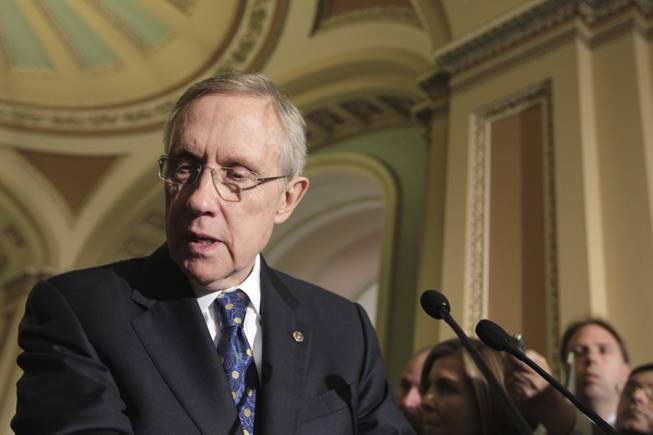
AP Photo/J. Scott Applewhite
Senate Majority Leader Harry Reid speaks to reporters on Capitol in Washington, Tuesday, May 3, 2011, following the Democrats’ weekly policy luncheon.
Wednesday, May 11, 2011 | 11:28 a.m.
Related Story
Sun Coverage
Senate Majority Leader Harry Reid reintroduced the DREAM Act in the Senate on Wednesday, less than 24 hours after President Obama called on Congress to take steps forward on a comprehensive immigration reform bill that would put the nation’s 11 million undocumented immigrants on a pathway toward citizenship.
The DREAM Act is only one piece of the immigration puzzle, but it caters to a group of undocumented immigrants who are considered the most sympathetic: it provides a route to citizenship for current college students and military enlistees who were brought to the U.S. as dependent children, through no fault of their own.
Because it’s a fairly popular provision of the immigration bill, the DREAM Act has served both as the linchpin to hold together the diverse array of enforcement enhancements and visa expansions that collectively comprise “comprehensive immigration.” It also serves as the last and best hope to give undocumented immigrants -- and by extension, the majority of the Hispanic voting community -- some sort of victory to hang their hat on.
In the last few years though, even the DREAM Act has proven impossible to get past the Senate. Last year, Reid tried to bring it to the floor twice: the first time, pre-midterm election 2010, its fate perished with a defense authorization bill; and the second, during the lame-duck period, it fell five votes short of passing a needed filibuster-proof hurdle. The final Senate vote, 55-41, closely reflected the country’s attitude toward the legislation at the time, as captured in a Gallup poll, which found 54 percent of American citizens wanted the DREAM Act, while 42 percent did not.
The Democrat-controlled House did pass the bill last December, by a slim margin.
While Reid did not get his full caucus of 59 Democrats to support the DREAM Act last year, most Republicans who have supported the measure in years past -- such as Sens. John Cornyn of Texas, Jon Kyl of Arizona, John McCain of Arizona and Lindsey Graham of South Carolina -- also withheld their votes, objecting that an independent piece of amnesty-granting legislation shouldn’t be allowed to move without some sort of counterbalance to increase immigration enforcement, which was the original concept behind the more comprehensive approaches to immigration changes.
McCain added Wednesday that he’d “also like to see them introduce legislation that also calls for a guest worker program.
Reid indicated Wednesday he’d consider attaching the DREAM Act to one workplace enforcement measure that’s expected to move through the House later this year: a measure to require all employers to use E-Verify, the government’s Internet-based work eligibility verification system.
In congressional cycles past, the loudest immigration advocates have balked at such an expansion, arguing that error rates in the system, which has been shown to be more than 99 percent accurate but depends on Social Security data that is faulty about 4 percent of the time, mean it’s not ready for a full roll-out. But Reid suggested that “it may be the vehicle we need over here to get this done.”
If that means the plan is to push for a somewhat dressed-up DREAM Act instead of a full comprehensive immigration reform bill -- for which lawmakers say there is a “chance” but don’t seem particularly convinced that the 112th Congress is the best chance -- it won’t come as a surprise, given the Democrats’ depleted majority in the Senate, and the Republican leadership in the House. While immigration has never been an issue that cleaves precisely along party lines, the bulk of its backers are Democrats.
But Reid hasn’t said when he plans to move on the DREAM Act yet.


Join the Discussion:
Check this out for a full explanation of our conversion to the LiveFyre commenting system and instructions on how to sign up for an account.
Full comments policy